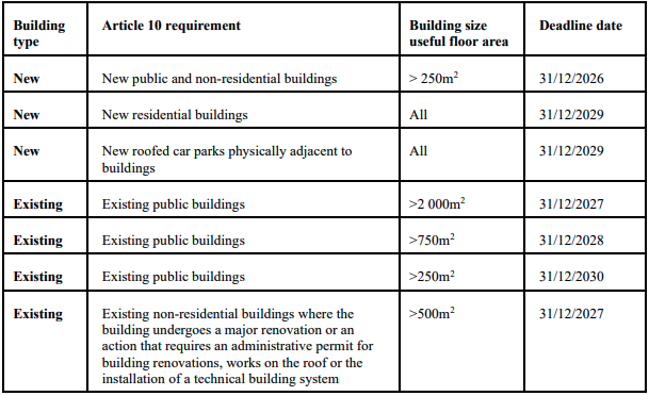What’s EUp : New guidelines for the EPBD
Fossil fuel boilers banned, solar mandatory — what this means for your city
On the 30th of June, the European Commission approved the content of the notice providing guidance on the recast Energy Performance of Building Directive (EPBD). This will help Member States that are required to transpose the EPBD into national law by May 2026. This notice includes important information for municipalities, read along if you want to learn more about the most recent EU updates on the phase out of fossil fuel boilers, solar energy in buildings and buildings renovation.
Fossil fuel boilers
Did you know that EU Member States are now required to plan for the phase-out of fossil fuel boilers by 2040? This obligation stems from the recast EPBD adopted in 2023.
The revised EPBD introduces several provisions to support this transition:
- Article 17(15) mandates an end to public financial support for stand-alone fossil fuel boilers.
- Article 3 and Annex II require that National Building Renovation Plans (NBRPs) include concrete policies and measures aiming at a complete phase-out of fossil fuel boilers by 2040.
- Article 13(1) provides a legal basis for national bans on fossil fuel boilers by allowing Member States to set requirements based on greenhouse gas emissions, renewable share, or fuel type.
- Article 13(7) calls on Member States to make best efforts to replace existing stand-alone fossil fuel boilers, aligned with their national phase-out plans.
To address previous uncertainties, the European Commission has now issued guidance clarifying key terms and expectations:
Key clarifications:
- For the definition of fossil fuel boiler what matters is the energy source used in 2040. For example, a heat pump running on fossil-based electricity would not be considered a fossil fuel boiler. The definition covers space heaters, water heaters, and combination systems.
- Local heating and cooling plans must assess the appliances and systems in the local building stock—critical data for municipalities preparing renovation strategies. Right on line with Energy Cities recommandations here.
- While 2040 is an indicative target, Member States are expected to define credible policies and measures to meet it. This is closely linked to the Renewable Energy Directive, which sets a 49% renewable energy target in the buildings sector by 2030.
- Energy efficiency is recognised as a key enabler. However, the Commission’s emphasis on “renewable gas” raises concerns, given its limited availability and environmental impacts.
Make sure to review your country’s National Building Renovation Plan (NBRP) to understand how the phase-out of fossil fuel boilers will be implemented nationally. And remember: NBRPs must be developed through public consultation and the first draft is expected for end of 2025.
Solar energy in buildings
As you might remember, the recast EPBD also established an EU solar mandate: as from next year, new commercial and public buildings larger than 250m² will be required to include solar installations.
Beside providing some clarity on definitions and on the interpretation of terminology used in the directive that are relevant for the implementation of solar energy in buildings (Art 10), the Commission has now provided guidance on some key aspects such as:
- Design of new buildings: when designing a building, architects and other construction professionals must consider its potential for generating solar energy (solar PV, thermal and a combination of both, on all available surfaces not just the roof) alongside other design parameters. Solar maps at local and regional level are identified as good support tools for this purpose.
- Permit granting procedure: Article 10 of EPBD aligns permitting and grid connection procedures for solar installations on buildings with the simplified processes from the Renewable Energy Directive (RED). Under RED, permits must be granted within one month for solar systems up to 100 kW, and within three months for building-integrated systems. For grid connections of installations up to 10.8 kW, only notification is required, and if the operator does not object within a month, connection proceeds. Member States may raise this threshold to 50 kW.
- Timeline for the deployment of solar installations: specific deadlines are now defined according to different typologies of buildings.

The document also highlights some exemptions and best practices of solar integration on historical buildings and presents options for the administrative, technical and financial support measures for solar deployment such as one stop shops, municipal subsidy programmes or subsidies for vulnerable households.
Renovation and zero emission buildings
The EPBD recast aims to boost the energy performance of both existing and new buildings across Europe. It sets clear targets to reduce energy consumption in residential and non-residential sectors, with a strong focus on renovating the worst-performing buildings. A helpful overview of objectives and timelines is available in BPIE’s guide (pages 16–17).
A key instrument introduced is the Minimum Energy Performance Standards (MEPS), which prioritise renovation of the worst-performing buildings, based on thresholds set by each Member State. Two implementation approaches are proposed:
- Centralised: National authorities define uniform criteria.
- Decentralised: Criteria can be set locally or regionally, enabling municipalities, local authorities, one-stop shops, or regional bodies to lead on implementation.
Another important development is the rollout of Zero-Emission Buildings (ZEB). From 2028, all new public buildings owned by public authorities must be zero-emission; from 2030, the rule applies to all new buildings. ZEBs must meet stringent energy performance criteria and have no on-site fossil fuel use, in alignment with the Renewable Energy and Energy Efficiency Directives.
The EPBD also takes a whole-life carbon approach, requiring consideration of emissions from construction materials, transport, renovation, and maintenance—alongside operational emissions. The guidance supports Member States in defining methods, responsibilities, and data requirements to capture this full emissions profile. This might encourage more attention to sufficiency and circularity measures.
Local authorities should also note new provisions encouraging the integration of cycling facilities and EV charging infrastructure in both new and existing buildings.
Finally, the EPBD positions One-Stop Shops (OSS) as key enablers of renovation. Member States must ensure at least one OSS per 80,000 inhabitants or per region. OSS are expected to offer both physical and online services, providing advice, support with financing, and aggregating small projects. Their functions may extend to energy sufficiency and circularity, aligned with similar requirements under the Energy Efficiency Directive.
While the guidance suggests existing local energy agencies could serve this role, it misses the opportunity to clearly link OSS development with local and regional authorities, who are best placed to respond to territorial needs.

